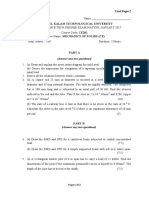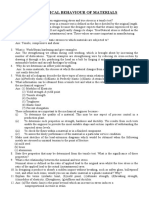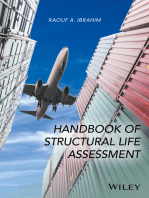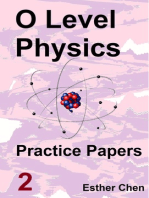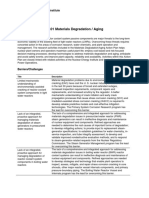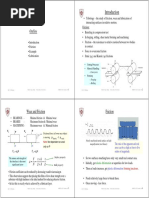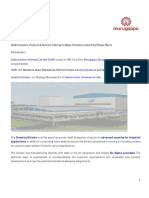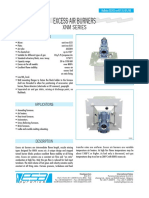Assignment 1 Mech 321 Properties and Failure of Materials Jan 2009
Uploaded by
DSGAssignment 1 Mech 321 Properties and Failure of Materials Jan 2009
Uploaded by
DSGAssignment 1 Mech 321 Properties and Failure of Materials Jan 2009
Question 1:
(a) The most important mechanical properties are: yield strength, ductility, hardness, fracture
toughness, young modulus, tensile strength. In your own words, describe your
understanding of these properties.
(b) What is elastic recovery? Mention one real-life example where this phenomenon may be
encountered.
(c) What is the physical meaning of strain hardening exponent (n in Hollomon’s equation)?
If you are to select a sheet metal for making cylindrical parts using deep drawing, would
you select a material with low or high n? Why?
Question 2:
(a) Show that Equations 6.18a and 6.18b (Callister) are valid when there is no volume
change during deformation.
(b) For a tensile test, it can be demonstrated that necking begins when dσT/dεT = σT,
determine the value of the true strain at this onset of necking.
(c) Explain the difference between resolved shear stress and critical resolved shear stress.
Question 3:
The following data are collected during a tensile test in which the starting gage length = 125.0
mm and the cross- sectional area = 62.5 mm2:
Load (N) 0 17,793 23,042 27,579 28,913 27,578 20,462
Length (mm) 0 125.23 131.25 140.05 147.01 153.00 160.10
The maximum load is 28,913 N and the final data point occurred immediately prior to failure. (a)
Plot the engineering stress strain curve. Determine: (b) yield strength Y, (c) modulus of elasticity
E, (d) tensile strength TS.
Question 4:
A cylindrical metal specimen 15.0 mm in diameter and 150 mm long is to be subjected to a
tensile stress of 50 MPa; at this stress level the resulting deformation will be totally elastic.
(a) If the elongation must be less than 0.072 mm, which of the metals in table 6.1 (Callister)
are suitable candidates? Why?
(b) If, in addition, the maximum permissible diameter decrease is 2.3 ×10-3 mm when the
tensile stress of 50 MPa is applied, which of the metals that satisfy the criterion in part (a)
are suitable candidates? Why?
Assignment 1 Mech 321 Properties and Failure of Materials Jan 2009
Question 5:
Consider a metal single crystal oriented such that the normal to the slip plane and the slip
direction are at angles of 43.1° and 47.9°, respectively, with the tensile axis. If the critical
resolved shear stress is 20.7 MPa will an applied stress of 45 MPa cause the single crystal to
yield? If not, what stress will be necessary?
Question 6:
A 10-mm-diameter Brinell hardness indenter produced an indentation 1.62 mm in diameter in a
steel alloy when a load of 500 kg was used. (a) Compute the HB of this material. (b) What will
be the diameter of an indentation to yield a hardness of 450 HB when a 500 kg load is used? (c)
Estimate the tensile strength of the two materials.
You might also like
- Safety Distance: Rules For Pressure Testing Lloyds Register (96-02)67% (6)Safety Distance: Rules For Pressure Testing Lloyds Register (96-02)2 pages
- 11CD108 Plasticity and Metal Forming - First Series Test PART-A (9 X 2 18 Marks) Answer ALL QuestionsNo ratings yet11CD108 Plasticity and Metal Forming - First Series Test PART-A (9 X 2 18 Marks) Answer ALL Questions1 page
- Technical Report On Electrostatic Precipitator: Geeco Enercon PVT LTD Tiruchirapalli - 620015 IndiaNo ratings yetTechnical Report On Electrostatic Precipitator: Geeco Enercon PVT LTD Tiruchirapalli - 620015 India21 pages
- Tutorial 4_Part II - Strength of MaterialsNo ratings yetTutorial 4_Part II - Strength of Materials3 pages
- Excericse Ch4 Failure Theories ExcerciseNo ratings yetExcericse Ch4 Failure Theories Excercise5 pages
- B3B032 Total Pages:2: (Answer Any Two Questions)No ratings yetB3B032 Total Pages:2: (Answer Any Two Questions)11 pages
- NCERT Solutions For Class 11 Physics Chapter 9 Mechanical Properties of SolidsNo ratings yetNCERT Solutions For Class 11 Physics Chapter 9 Mechanical Properties of Solids25 pages
- Elementary Fracture Mechanics Solved ProblemsNo ratings yetElementary Fracture Mechanics Solved Problems14 pages
- WWW - Manaresults.Co - In: (Common To Me, MCT, MMT, Ae, Ame, MSNT)No ratings yetWWW - Manaresults.Co - In: (Common To Me, MCT, MMT, Ae, Ame, MSNT)3 pages
- Answer Any Three Full Questions, Each Carries 10 Marks: Reg No.: - NameNo ratings yetAnswer Any Three Full Questions, Each Carries 10 Marks: Reg No.: - Name10 pages
- MEC2308 - Mechanics of Materials 2 FINALFINALNo ratings yetMEC2308 - Mechanics of Materials 2 FINALFINAL4 pages
- Tutorial Answers - Mechanical Behaviour of MaterialsNo ratings yetTutorial Answers - Mechanical Behaviour of Materials2 pages
- Tme 313 - Semester Major Take Home Exercises - 2023 2024No ratings yetTme 313 - Semester Major Take Home Exercises - 2023 202411 pages
- Mechanical Failure Fracture Mechanisms: Issues To Address..No ratings yetMechanical Failure Fracture Mechanisms: Issues To Address..6 pages
- Assignment - Chapter 1 - DHRUVKUMAR PATELNo ratings yetAssignment - Chapter 1 - DHRUVKUMAR PATEL4 pages
- Discussion Solution Chapter 5 Mechanical PropertiesNo ratings yetDiscussion Solution Chapter 5 Mechanical Properties3 pages
- Dynamic Damage and FragmentationFrom EverandDynamic Damage and FragmentationDavid Edward LambertNo ratings yet
- Physical Metallurgy-18 Heat Treatment of SteelNo ratings yetPhysical Metallurgy-18 Heat Treatment of Steel7 pages
- Chapter Outline:: Heat Treatment (And Temperature)No ratings yetChapter Outline:: Heat Treatment (And Temperature)24 pages
- How To Use This Severity Chart: Example Fan 625 Um (25 Mils)0% (1)How To Use This Severity Chart: Example Fan 625 Um (25 Mils)2 pages
- EPRI Materials Degradation - Aging 2008 - P041.01No ratings yetEPRI Materials Degradation - Aging 2008 - P041.0144 pages
- 3 APH PERFORMANCE in NTPC STATIONS AjaySharmaNo ratings yet3 APH PERFORMANCE in NTPC STATIONS AjaySharma15 pages
- @ M/S.N.R.Agarwal Industries LTD Unit 3&4, Gidc, Phase-3, Vapi, GujratNo ratings yet@ M/S.N.R.Agarwal Industries LTD Unit 3&4, Gidc, Phase-3, Vapi, Gujrat28 pages
- Technofit Technofit: Geeco Seminar Geeco SeminarNo ratings yetTechnofit Technofit: Geeco Seminar Geeco Seminar12 pages
- Fighting Fire With CO: by Dominique Dieken, P.E., Starr Technical Risks Agency IncNo ratings yetFighting Fire With CO: by Dominique Dieken, P.E., Starr Technical Risks Agency Inc6 pages
- Reliability Improvement Bearing MaintenanceNo ratings yetReliability Improvement Bearing Maintenance8 pages
- Cladding Technology Processes and ImagesNo ratings yetCladding Technology Processes and Images7 pages
- Performance Improvement by Expert ConsultancyNo ratings yetPerformance Improvement by Expert Consultancy19 pages
- MSM GTU Study Material E-Notes Unit-5 23112020052908AMNo ratings yetMSM GTU Study Material E-Notes Unit-5 23112020052908AM14 pages
- The Anomalous Skin Effect in Metals in A Magnetic Field: +2E' (O) 4niwc-J (K)No ratings yetThe Anomalous Skin Effect in Metals in A Magnetic Field: +2E' (O) 4niwc-J (K)5 pages
- E-20 Load Heat Estimation Completada 07-01-17No ratings yetE-20 Load Heat Estimation Completada 07-01-1792 pages
- Optimization of Welding Parameters and Study On Mechanical andNo ratings yetOptimization of Welding Parameters and Study On Mechanical and15 pages
- Chapter-04-Applications-Thermodynamics-Earth 4744 0 PDFNo ratings yetChapter-04-Applications-Thermodynamics-Earth 4744 0 PDF43 pages
- POSTER - N.L.Tapia Falcon, M.Huanca Ccamerccoa PDFNo ratings yetPOSTER - N.L.Tapia Falcon, M.Huanca Ccamerccoa PDF1 page
- Module 3 - Switched Reluctance Motor Noices.No ratings yetModule 3 - Switched Reluctance Motor Noices.2 pages
- X-Ray Inspection Radiation Detection Radiation DetectionNo ratings yetX-Ray Inspection Radiation Detection Radiation Detection25 pages
- Caterpillar - Motoniveladora 24m - 02 - Plano ElectricoNo ratings yetCaterpillar - Motoniveladora 24m - 02 - Plano Electrico2 pages
- CHAINGUARD-DB For Filler Dispersion (General)No ratings yetCHAINGUARD-DB For Filler Dispersion (General)29 pages




























